Menus
- Italo-V2 against Japanese four-four
- Racetrack
- Ducati 899 Panigale on the racetrack
- Grab the Suzuki GSX-R 750 by the horns
- Race track classification goes to little Panigale
- Country road
- Clear victory for the newer concept
- Ducati 899 Panigale
- HP setup race track (country road)
- Suzuki GSX-R 750
- HP setup race track (country road)
- PS readings
- Readings
- Performance
- rating
- HP conclusion
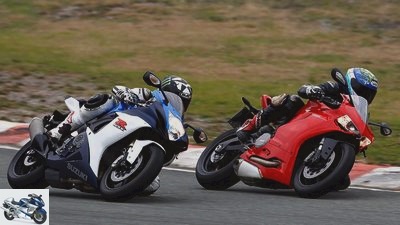
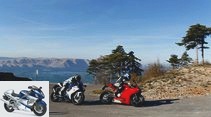
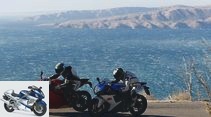
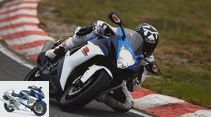
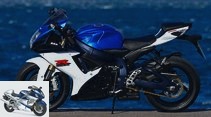
28 photos
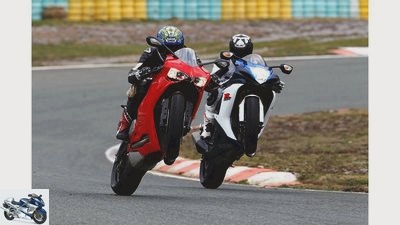
1/28
Crime scene “Automotodrom Grobnik” near Rijeka, Croatia: The brand new Ducati 899 Panigale challenges the battle-savvy evergreen Suzuki GSX-R 750 to a duel on the historic race track.
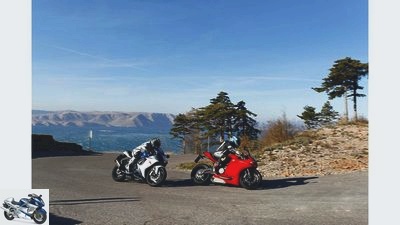
2/28
Despite the older concept, the Suzuki keeps up very well with the Panigale, especially on country roads. The Suzi-Plus is comfort and pulling power.
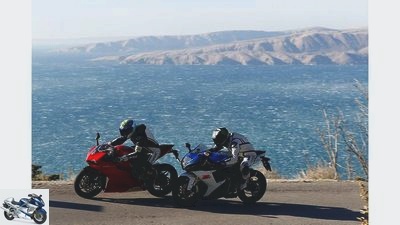
3/28
Although they are not used as often in public areas as they are on the race, ABS offer & Co. also here more security and convey a better feeling.
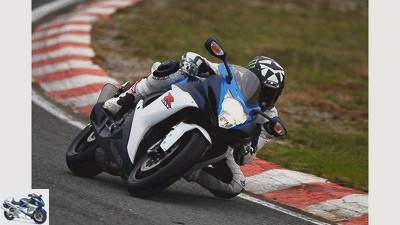
4/28
You won’t find any contemporary features in the Suzuki GSX-R 750.
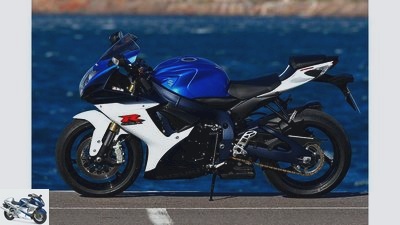
5/28
The Suzuki has a slightly chubby outfit.
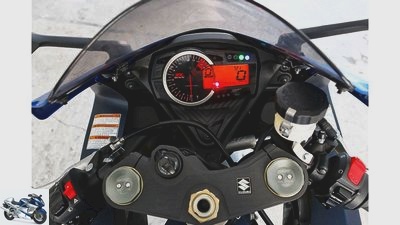
6/28
The Suzuki cockpit with a large analog tachometer is very clear and easy to read.
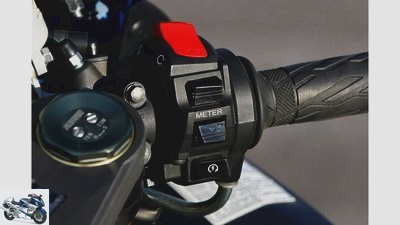
7/28
The switches on the handle.
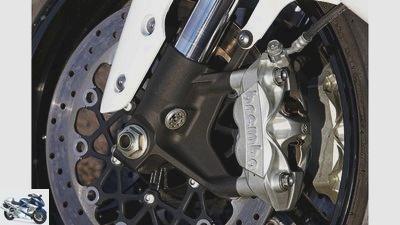
8/28
The brembos seem a bit toothless. Sharper pads would do the braking system good.
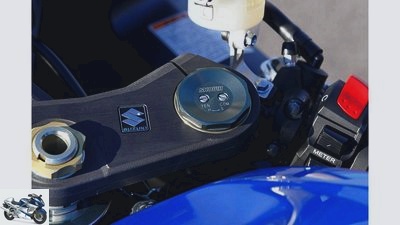
9/28
With the fork pushed through by five millimeters, the Suzi angles noticeably more manageable.
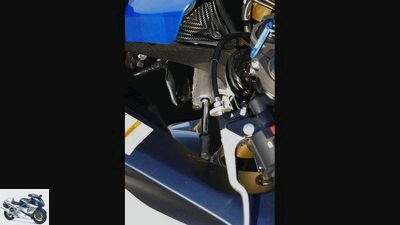
10/28
The Suzuki GSX-R 750.
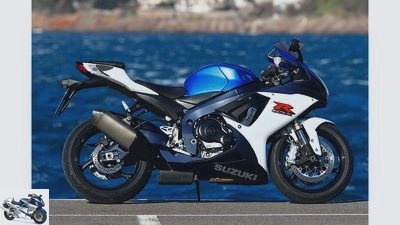
11/28
Just like in the Panigale, it has a fine Big Piston fork with plenty of damping.
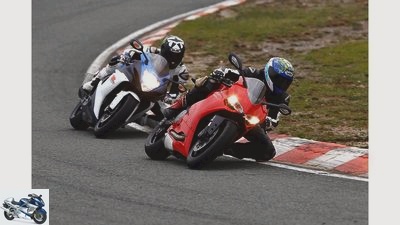
12/28
The standard slippers (rear in the new-fangled 180/60 dimension) are good-natured and work very well even at outside temperatures of just under ten degrees.
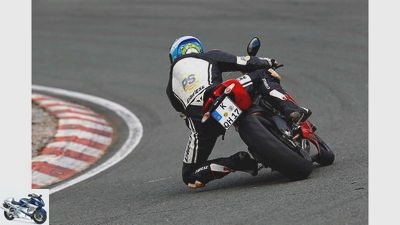
13/28
The 899 Panigale is perfectly balanced, handy, stable and has great brakes. A small downer is the drop in performance at medium speeds.
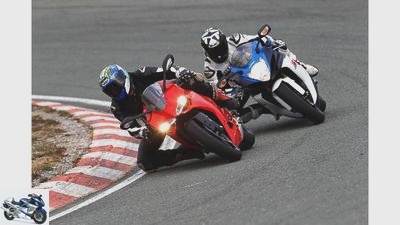
14/28
So put on racing soles and go! The Pirelli Diablo Supercorsa in the hardest mixture (SC2) is used as a uniform rubber.

15/28
As a small offshoot of the powerful 1199 Panigale superbike, the 899 earned a lot of praise at its premiere in autumn.
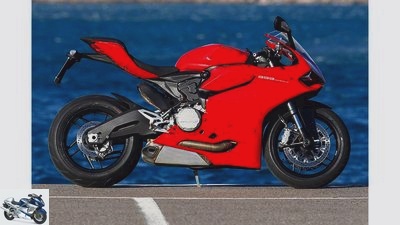
16/28
Very well maneuverable and controllable, with a lot of polish and behavior, it clearly distinguishes itself from its big, rough sister.
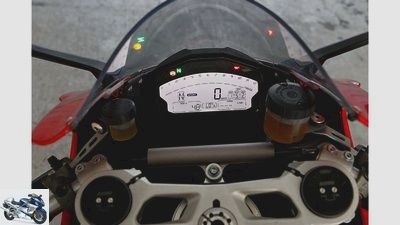
17/28
The menu navigation is much more complicated than with the large Panigale. Does it have to be that way?
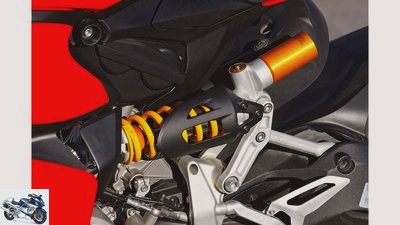
18/28
The shock absorber works a little less tightly, but is also sufficiently damped for speedy hobbyists.
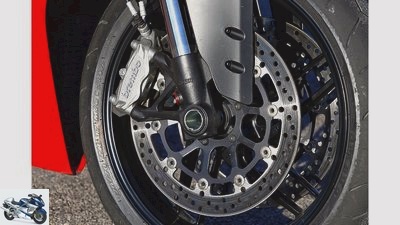
19/28
Crisp, transparent and with a high stamina: the Ducati stoppers are a poem.
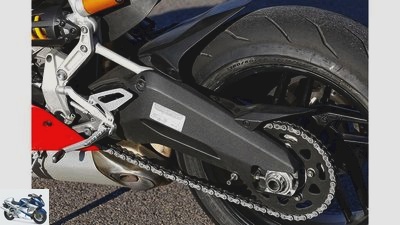
20/28
The chain drive of the Ducati 899 Panigale.
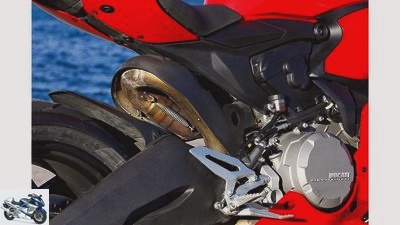
21/28
The sinuous manifold creates exhaust gas paths of equal length – important for perfect gas exchange.
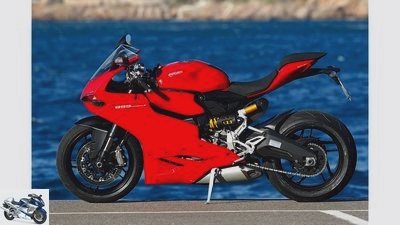
22/28
The Ducati 899 Panigale offers different driving modes, an adjustable traction control (DTC), an automatic gearshift (DQS) and the also adjustable engine brake EBC.
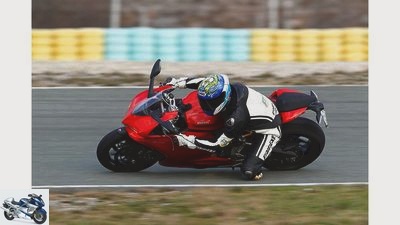
23/28
The Panigale cuts a great figure on the race track. A short steering impulse is enough and bang, and the Italian turns into a corner.
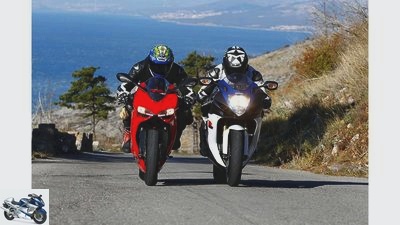
24/28
Feeling is also created by sound. Regardless of whether you are into hot four-cylinder screeching or love dull V2 banging – the two athletes deliver the finest listening pleasure for every taste.
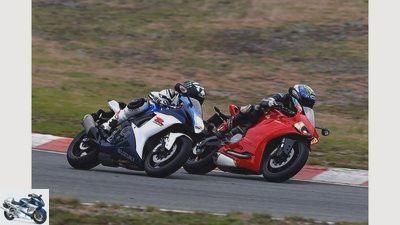
25/28
Stunned faces when looking at the stopwatch: The aged Gixxe only loses two academic tenths of 1.40.9 minutes compared to the progressive Duc (1.40.7 min)!
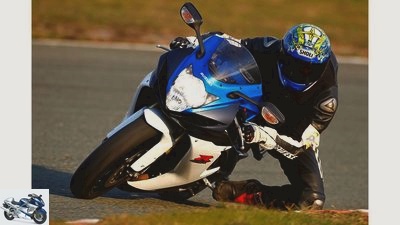
26/28
Once on course, it keeps the line clean even in the deepest lean angles. In addition, it is equipped with a slipper clutch-
equipped, which effectively prevents brake pads.
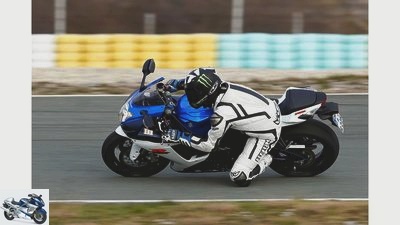
27/28
When it comes to anchoring, the Suzuki is losing out. The pure deceleration performance is okay, but the pilot has to act like a blacksmith for short braking distances.
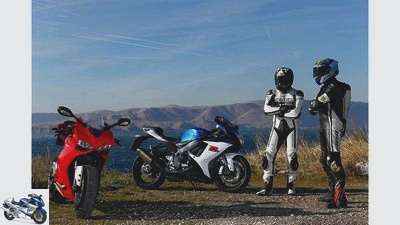
28/28
In a direct comparison, the Ducati comes in first and the Suzuki in second place.
Ducati Panigale 899 and Suzuki GSX-R 750 in the test
Italo-V2 against Japanese four-four
Content of
Two-cylinder versus four-cylinder, advanced driver assistance systems meet technical purism, classy forms meet stylish home cooking: a clear victory for the more modern concept? Wait! We test Ducati Panigale 899 and Suzuki GSX-R 750 in comparison.
Racetrack
Crime scene “Automotodrom Grobnik” near Rijeka, Croatia: The brand new Ducati challenges on the historic race track 8th99 Panigale duel the seasoned evergreen Suzuki GSX-R 750. As a small offshoot of the powerful 1199 Panigale superbike, the 899 earned a lot of praise at its premiere in autumn. Very well maneuverable and controllable, with a lot of polish and demeanor, it clearly distinguishes itself from its big, rough sister. A wonderful analogy to the Suzuki, because it is also more sociable than its strong, asphalt-shredding Superbike counterpart. So what could be more natural than a comparison
Buy complete article

Ducati Panigale 899 and Suzuki GSX-R 750 in the test
Italo-V2 against Japanese four-four
Ducati 899 Panigale and Suzuki GSX-R 750. Now it’s time to hit the slopes. So put on racing soles and go! The Pirelli Diablo Supercorsa in the hardest compound (SC2) is used as a uniform rubber. The slippers (rear in the new-fashioned 180/60 dimension) are good-natured and work very well even at outside temperatures of just under ten degrees. The fact that the front tire in particular tears on the flanks after around two hours of driving is due to the extremely grippy, tire-killing slope. Side tip: If you don’t work on the last tenth of a second, you will find good, street-legal sports tires in Rijeka.
Ducati 899 Panigale on the racetrack
The Ducati 899 Panigale cuts a fine figure on the race track. A short steering impulse is enough and bang, and the Italian turns into a corner. It circles the radii accurately and stably, the pilot only has to keep it in line with a slight amount of physical effort when the bike is at a great incline, as the bike is minimally pushed outwards. At 710 millimeters, the handlebars, which are unusually wide for a super sports car, support the Panigale driver in this exercise. The fork responds excellently and has immense damping reserves. Because of the sometimes extremely pitted subsurface, we only turn the adjusting screw gently.
The shock absorber of the Ducati 899 Panigale works a little less tightly, but is also sufficiently damped for quick hobbyists. The brakes meet the highest demands. They pack a lot, are easy to dose and never fail. In addition, the adjustable and disengageable ABS supports even ambitious late brakes. At the sharpest of three levels (one), it only intervenes on the front wheel, which enables advanced skiers to make splendid braking drifts. However, an anti-hopping clutch is missing so that this always works perfectly. If you don’t like a rear wheel breaking away, choose level two. This keeps the wheels on track, but stoppies are possible to a limited extent. In position three, the ABS regulates very early and the rear wheel stays on the ground – the perfect level for cautious contemporaries or wet conditions. In addition to the anti-lock device, the small Panigale also offers other contemporary features: various driving modes, adjustable traction control (DTC), an automatic gearshift (DQS) and the also adjustable engine brake EBC.
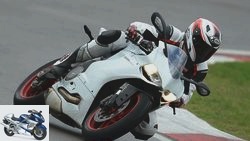
Super athlete
Ducati 899 Panigale in the driving report
When reason is fun
read more
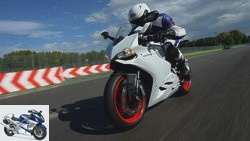
Super athlete
Ducati 899 Panigale in the PS driving report
Waiver? Only on the single-sided swing arm
read more
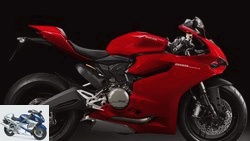
Super athlete
Presentation of the Ducati 899 Panigale
New super sports car from Bologna
read more
Grab the Suzuki GSX-R 750 by the horns
You won’t find any of that on the Suzuki GSX-R 750. In general, the Gixxe looks quite antiquated in contrast to the Ducati Panigale 899. It starts with the slightly chubby outfit, continues with the inactive driver position with a deep seat and comparatively narrow handlebars, and culminates in the lack of driver assistance. It was last renovated for the 2011 model year – especially in times of modern electronic control systems, a small eternity.
After all, just like the Ducati Panigale 899, it has a fine Big Piston fork with plenty of damping. It guides the front wheel very safely and reports clearly on the driving condition. The shock absorber, on the other hand, could use a little more damping. When dancing on the last groove, the rear section appears slightly unstable, and the jockey also misses the last bit of transparency. When turning in, the rear-heavy Suzi needs significantly more power than the Duc. Countermeasure: Lower the front by moving the fork five millimeters up through the bridges. After this cure, the Gixxe angles noticeably more light-footed, but she still wants to be grabbed by the horns when turning. This is not due to its weight – after all, the Suzuki GSX-R 750 weighs six kilograms less fat than the small Ducati (194 to 200 kilograms). Apparently the Italian distributes her pounds more skilfully, which is why she scores heavily in terms of driving characteristics.
The Suzuki GSX-R 750 also loses out when it comes to anchoring. The pure deceleration performance is okay, but the pilot has to act like a blacksmith for short braking distances. Somewhat more aggressive rubbers would certainly help here. Does the Japanese have any advantage over her opponent on the chassis side? Yes, absolutely! Once on course, it keeps neatly in line even on the deepest slopes. In addition, it is equipped with an anti-hopping clutch, which effectively prevents brake pistons. Stunned faces when looking at the stopwatch: The aged Gixxe only loses two academic tenths of 1.40.9 minutes compared to the progressive Ducati Panigale 899 (1.40.7 min)! How is that possible?
All used offers: Suzuki GSX-R 750
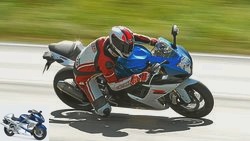
Super athlete
The super sports car from Suzuki in the three-quarter liter class
Suzuki GSX-R 750 for 27 years
read more
Race track classification goes to little Panigale
Put on racing soles and go! The Pirelli Diablo Supercorsa in the hardest mixture (SC2) is used as a uniform rubber.
On the one hand, the ratio of the Ducati Panigale 899 does not fit perfectly with the Rijeka circuit. In some corners the second course is too short, the third too long. This means that the Italian cannot always work in her most powerful and high-torque range. This only starts from around 7000 rpm, below which there is a noticeable gap in performance. Similar to its big sister 1199 Panigale, the 899 is designed for a two-cylinder with a very short stroke.
Due to the concept, the Suzuki GSX-R 750 has significantly more speed reserves, which saves it some gear changes. In addition, the top performance of the Japanese is, despite a clear displacement disadvantage with measured 138 hp, only four hp below that of the Ducati. The bottom line is that the race track ranking goes clearly to the Duc – for two reasons: firstly, thanks to its better chassis, the driver can shoot around the course with much less stress, and secondly, ABS help & Co. to prevent departures, which also lowers the stress level.
Country road
Despite the older concept, the Suzuki keeps up very well with the Panigale, especially on country roads. The Suzi-Plus is comfort and pulling power.
Although they are not used as often in public areas as they are on the race, these systems also offer more security and convey a better feeling. But feeling is also created by sound. Regardless of whether you are into hot four-cylinder screeching or love dull V2 banging – the two athletes deliver the finest listening pleasure for every taste. However, the Ducati Panigale 899 hammers so loudly that the eavesdroppers glow. In addition, the two-cylinder needs quite high engine speeds on country roads when the pilot is in combat mode. With its silky smooth engine running and the finest manners when applying the gas, the Panigale partially compensates for these inadequacies. In addition, shifting up under load thanks to the Quickshifter is endless fun.
Clear victory for the newer concept
Although it has no automatic gearshift, gear changes are also very smooth on the Suzuki GSX-R 750. It even handles downshifts a little better than the Panigale. In terms of throttle response and smoothness, the quad does not quite reach the level of the Ducati drive. Because of its high maneuverability, the Japanese translated it comparatively briefly. Because of this, and because of the homogeneous power output and the excellent controllable clutch, the Suzi burns her opponent at least six tenths (8.6 s to 9.2 s) in the sprint from zero to 200 km / h. In addition, it distances the Ducati Panigale 899 by just under a second (10.2 s to 11.1 s) when pulling through in the last gear from 50 to 150 km / h. Even if the performance diagram says otherwise, the Suzuki of the Panigale is not so easy to take the butter off the bread.
The same applies to the chassis. The Suzi shock absorber is sufficiently tightly damped on country roads and has separate high and low-speed compression stages. With the right setup, the Monoshock smooths especially hard edges better than that of the Ducati Panigale 899, which works a bit bumpy on very lousy terrain. In addition, the Suzuki GSX-R 750 with the standard Bridgestone BT 016 tires in the special specification “G” turns noticeably more manageable in the corners than on the racing slippers. The catch: At an estimated 40 degrees incline, the skin gives the pilot the feeling that the load is about to slip over the front wheel – clearly too early! The Pirelli Diablo Rosso Corsa of the Ducati is not that handy, but it offers plenty of support in every situation. So a clear victory for the more modern concept? Yes! But in terms of pure performance, the two are closer together than expected. And that’s a real surprise.
Ducati 899 Panigale
Very well maneuverable and controllable, with a lot of polish and behavior, it clearly distinguishes itself from its big, rough sister.
drive
Two-cylinder 90-degree V-engine, four valves / cylinder, 109 kW (148 PS) at 10 750 / min *, 99 Nm at 9000 / min *, 898 cm³, bore / stroke: 100.0 / 57.2 mm, compression ratio: 12.5: 1, ignition / injection system, 62 mm throttle valves, hydraulically operated multi-disc oil bath clutch, six-speed gearbox, G-Kat, chain, traction control.
landing gear
Load-bearing motor with light metal subframe, steering head angle: 66 degrees, caster: 96 mm, wheelbase: 1426 mm, upside-down fork, Ø fork inner tube: 43 mm, adjustable spring base, rebound and compression. Central spring strut with deflection, adjustable in spring base, rebound and compression. Suspension travel front / rear: 120/130 mm.
Wheels and brakes
Light alloy cast wheels, 3.50 x 17 / 5.50 x 17, front tires: 120/70 ZR 17, rear: 180/60 ZR 17, first tires: Pirelli Diablo Rosso Corsa, 320 mm double disc brakes with radially attached four-piston fixed calipers at the front, 245 -mm single disc with two-piston fixed caliper at the rear.
measurements and weight
Length / width / height: 2075/820/1100 mm, seat / handlebar height: 825/860 mm, handlebar width: 710 mm, 200 kg fully fueled, v./h .: 52.4 / 47.6%.
Rear wheel power in last gear: 96 kW (131 PS) at 248 km / h
consumption
Fuel type: Super unleaded. Average test consumption: 6.9 liters / 100 km, tank capacity 17 liters, range: 246 km
Base price: 15,490 euros (plus additional costs)
* Manufacturer information
HP setup race track (country road)
The shock absorber works a little less tightly, but is also sufficiently damped for speedy hobbyists.
| Ducati 899 Panigale | |
| fork | |
| stat.neg. Suspension travel | 36 mm (36 mm) |
| Pressure level | 6 U open (7 U open) |
| Rebound | 6 U open (6 U open) |
| level | default |
| Strut | |
| stat.neg. Suspension travel | 13 mm (13 mm) |
| Pressure level high | – |
| Low compression | 1 U open (completely open) |
| Rebound | 8 K open (13 K open) |
| level | default |
| all damping settings from completely closed counted; static negative spring deflection standing vertically without driver; U = revolutions; K = clicks |
|
Suzuki GSX-R 750
The Suzuki has a slightly chubby outfit.
drive
Four-cylinder in-line engine, four valves / cylinder, 110 kW (150 PS) at 13,200 / min *, 86 Nm at 11,200 / min *, 750 cm³, bore / stroke: 70.0 / 48.7 mm, compression ratio: 12, 5: 1, ignition / injection system, 42 mm throttle valves, mechanically operated multi-disc oil bath anti-hopping clutch, six-speed gearbox, G-Kat, chain.
landing gear
Light metal bridge frame, steering head angle: 66.5 degrees, caster: 97 mm, wheelbase: 1395 mm, upside-down fork, Ø fork inner tube: 41 mm, adjustable spring base, rebound and compression level. Central spring strut with deflection, adjustable in spring base, rebound and compression. Suspension travel front / rear: 120/130 mm.
Wheels and brakes
Cast light alloy wheels, 3.50 x 17 / 5.50 x 17, front tires: 120/70 ZR 17, rear: 180/55 ZR 17, initial tires: Bridgestone BT 016 “G”, 310 mm double disc brakes with radially attached four-piston fixed calipers at the front , 220 mm single disc with single-piston floating caliper at the rear.
measurements and weight
Length / width / height: 2040/820/1140 mm, seat / handlebar height: 805/845 mm, handlebar width: 635 mm, 194 kg fully fueled, v./h .: 52.6 / 47.4%.
Rear wheel power in last gear: 95 kW (129 PS) at 251 km / h
consumption
Fuel type: Super unleaded. Average test consumption: 7.3 liters / 100 km, tank capacity 17 liters, range: 232 km
Base price: 11,490 euros (plus additional costs)
HP setup race track (country road)
The Suzuki cockpit with a large analog tachometer is very clear and easy to read.
| Suzuki GSX-R 750 | |
| fork |
|
| stat.neg. Suspension travel |
34 mm (34 mm) |
| Pressure level |
6 U open (7 U open) |
| Rebound |
3 U open (4 U open) |
| level |
Front lowered by 5 mm |
| Strut |
|
| stat.neg. Suspension travel |
8 mm (8 mm) |
| Pressure level high |
2.75 U open (completely open) |
| Low compression |
0.25 U open (1.5 U open) |
| Rebound |
0.25 U open (2 U open) |
| level |
default |
| all damping settings from completely closed counted; static negative spring deflection standing vertically without driver; U = revolutions; K = clicks |
|
PS readings
Feeling is also created by sound. Regardless of whether you are into hot four-cylinder screeching or love dull V2 banging – the two athletes deliver the finest listening pleasure for every taste.
Readings
PS
The values measured by PS,
The performance diagram shows the difference in displacement from 898 (Ducati) to 750 (Suzuki) cubic centimeters – the Ducati 899 Panigale outperforms the Suzuki GSX-R 750 at every speed. In practice, however, mere power is only half the story. The performance depends a lot on the gear ratio, the power curve and the usable speed range. The Panigale falls into a noticeable torque hole between 4000 rpm and around 7000 rpm, which is why it has to be driven at high revs at a brisk pace. The performance of the GSX-R is much more homogeneous, which makes it easy to calculate. The dashed red line shows the power-reduced wet mode of the Panigale.
Performance
| Acceleration** | Draft** | Maximum- dizzy- ability * |
||||
| 0 -100 km / h |
0 -150 km / h |
0-200 km / h |
50-100 km / h |
100-150 km / h |
||
| Ducati 899 Panigale | 3.6 s | 5.9 s | 9.2 s | 5.6 s | 5.5 s | 270 km / h |
| Suzuki GSX-R 750 | 3.2 s | 5.2 s | 8.6 s | 5.3 s | 4.9 s | 280 km / h |
| * Manufacturer information; ** PS measurement | ||||||
rating
| Max. Points |
Ducati 899 Panigale |
Suzuki GSX-R 750 |
|
| drive | |||
| acceleration | 10 | 8th | 8th |
| Draft | 10 | 5 | 6th |
| Power delivery | 10 | 6th | 7th |
| Responsiveness | 10 | 9 | 7th |
| Load change reaction | 10 | 9 | 8th |
| Running culture | 10 | 9 | 7th |
| Gear actuation | 10 | 9 | 8th |
| Gear ratio | 10 | 7th | 9 |
| Clutch function | 10 | 4th | 9 |
| Traction control | 10 | 9 | – |
| Subtotal | 100 | 75 | 69 |
| landing gear | |||
| Driving stability | 10 | 8th | 7th |
| Handiness | 10 | 9 | 7th |
| Cornering stability | 10 | 9 | 8th |
| feedback | 10 | 8th | 7th |
| Suspension tuning front |
10 | 9 | 9 |
| Suspension tuning back |
10 | 8th | 8th |
| Braking effect | 10 | 9 | 8th |
| Brake metering | 10 | 9 | 7th |
| Erection moment when braking |
10 | 9 | 7th |
| ABS function | 10 | 9 | – |
| Subtotal | 100 | 87 | 68 |
| Everyday life and driving fun | |||
| Sitting position | 10 | 8th | 7th |
| Windbreak | 10 | 6th | 6th |
| Furnishing | 10 | 9 | 5 |
| consumption | 10 | 6th | 5 |
| Driving fun | 10 | 9 | 8th |
| Subtotal | 50 | 38 | 31 |
| Total | 250 | 200 | 168 |
| placement | 1. | 2. | |
HP conclusion
In a direct comparison, the Ducati comes in first and the Suzuki in second place.
1st place: Ducati 899 Panigale
With ABS, traction control and other useful electronic features, the Panigale has a clear lead in points. In addition, it is perfectly balanced, handy, stable and has great brakes. A small downer is the drop in performance at medium speeds.
2nd place: Suzuki GSX-R 750
Suzi does well and doesn’t let herself be left out on the racetrack or on the country road. Nevertheless: Your concept is clearly grayed out, modernization urgently needed. When does Suzuki react?
Related articles
-
Ducati 959 Panigale, MV Agusta F3 800 and Suzuki GSX-R 750 in the test
Arturo Rivas 40 photos Arturo Rivas 1/40 The super sports cars Ducati 959 Panigale, MV Agusta F3 800 and Suzuki GSX-R 750. Arturo Rivas 2/40 MV Agusta F3…
-
Ducati 1199 Panigale S versus KTM RC8 R in comparison test
23 photos 1/23 The two super sports two-cylinder, KTM RC8 R and Ducati 1199 Panigale S, in a comparison test. They are the last…
-
Comparison test: Suzuki GSX-R 600 2010-2011
Comparison test: Suzuki GSX-R 600 2010/2011 Suzuki GSX-R: New versus old Contents of The engines of the two Suzuki GSX-R 600 roar sharply -…
-
BMW, Ducati, Suzuki and Triumph super sports cars in a comparison test
29 photos 1/29 Triumph Daytona 675, Ducati 848 Evo Corse SE, BMW S 1000 RR, Suzuki GSX-R 750. Different bikes – different cubic…
-
Ducati 999 S and Ducati 1199 Panigale S in comparison test
fact 14th photos fact 1/14 The rattling through the city with the Ducati 999 S is deep in the memory. But honestly, the current Ducati Panigale with the…
-
Super sports car Ducati 899 Panigale, Honda Fireblade SP Triumph Daytona 675 in the test
fact 31 photos fact 1/31 There are currently no brand new athletes. Some people therefore complain that nothing is moving anymore. Not correct! In the…
-
Comparison test: Ducati Diavel, Suzuki B-King and Yamaha Vmax
Jahn Comparison test: Power Bikes 2011 Ducati Diavel, Suzuki B-King and Yamaha Vmax Content of Big appearance, powerful sound waves, pressure from all…
-
Track test Ducati 999 R-Suzuki GSX-R 1000
Gargolov Track test Ducati 999 R / Suzuki GSX-R 1000 There is more to it … …than just whether the brand new Suzuki GSX-R 1000 or the sinfully…
-
Comparison test of V4 superbikes Ducati Panigale V4 S Aprilia RSV4 RF
fact 21 pictures fact 1/21 Ducati Panigale V4 S and Aprilia RSV4 RF in a comparison test. fact 2/21 Otherwise, the V4 RR adopts the concept of normal …
-
Ducati 1199 Panigale, EBR 1190 RX and KTM 1190 RC8 R.
Jahn 32 photos Jahn 1/32 Cloud-free sky, glorious sunshine, the rumble of thunder: three mighty V2 superbikes race down the slopes of Oschersleben and…